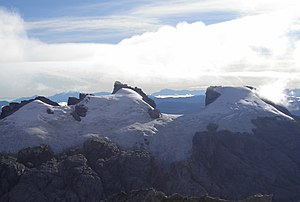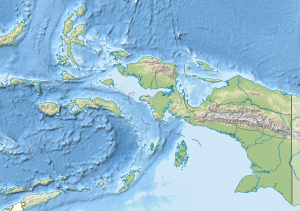Sumantri
| Sumantri | ||
|---|---|---|
|
Sumantri (center) and Ngga Pulu (right) from the south |
||
| height | 4870 m | |
| location | Papua Province , Indonesia | |
| Mountains | Maoke Mountains | |
| Dominance | 3.5 km → Carstensz pyramid (4884 m) | |
| Notch height | 350 m | |
| Coordinates | 4 ° 3 '43 " S , 137 ° 11' 7" E | |
|
|
||
| First ascent | February 1962 by Heinrich Harrer and Phil Temple | |
| particularities | One of the Seven Second Summits | |
The Sumantri (also Soemantri ) is a 4870 m high mountain in the Indonesian part of the island of New Guinea ( Papua Province ), it is part of the Sudirman Mountains in the western Maoke Mountains .
According to recent findings, the Sumantri is the second highest mountain on the Australian-oceanic continent and is therefore part of the mountaineering series of the Seven Second Summits . The Carstensz pyramid , located a few kilometers southwest, is the highest mountain on the continent at 4884 m and belongs to the much better known series of the Seven Summits . Due to measurement and definition problems, other mountains are or have been considered candidates for the Second Summit of Australia in the past (for details see section Alpinism ).
geography
Several of the highest peaks on the island of New Guinea are located in the western Maoke Mountains. The Sumantri is the highest peak in the Northwall Firn , a mountain range that runs from northwest to southeast and forms the northern boundary of a glacier valley (Meren Valley). Its southern boundary is represented by the almost parallel ridge of the Carstensz pyramid. The Northwall Firn drops very steeply to the northeast to the lower tropical vegetation zones.
In the course of the 20th century, several research expeditions documented the rapid retreat of glaciers in the Meren Valley and on the peaks, and the Sumantri is now an ice-free peak. A few hundred meters south-east of the rocky summit of Sumantri is the somewhat lower summit of Ngga Pulu, covered by glacial ice . It is now well-established that today's secondary summit, Ngga Pulu, even towered over the 4,884 meter high Carstensz pyramid a few decades ago due to a larger ice cover. Complete melting of all glaciers in the region is expected over the next few years.
Alpinism
In 1623 the Dutch navigator Jan Carstensz discovered the high and at the time heavily glaciated peaks inland from his ship off the south coast of New Guinea. These were later called Carstensz Toppen (Carstensz Mountains), from 1912 the first expeditions into the area took place. The first mountaineers there were the Dutchmen Anton Colijn , Jean-Jacques Dozy and Frits Wissel ; they climbed the neighboring Ngga Pulu in 1936. It is not known whether they also climbed the rocky summit of Sumantri. In 1962 at the latest, the first ascent of Sumantri was carried out by Heinrich Harrer and Phil Temple , whose expedition had also succeeded in the first ascent of the Carstensz pyramid.
At the beginning of the 21st century, the mountains of New Guinea increasingly moved into the focus of international mountaineering, it was about the first ascent of the second highest mountains of all seven continents ( Seven Second Summits ) and later also the three highest mountains ( Triple Seven Summits ).
Because of inaccurate measurements, numerous summit and pass heights in New Guinea were not exactly known. The major changes in the ice cover of important areas, which in some cases caused significant changes in altitude, made it more difficult.
Recent research has shown that the summit of Sumantri was not only higher than the other candidates for the title of the Second Summit of Oceania , but that at 350 meters for a four-thousand-meter peak it also has enough topographical prominence to be recognized as a mountain in its own right.
Previously, the most important protagonists in the race for the title “First at the Seven Second Summits” had favored other mountains. The South Tyrolean mountaineer Hans Kammerlander considered the 4730 m high Puncak Trikora to be the correct summit of the series of climbs. The Austrian Christian Stangl decided in 2007 for the 4862 m high Ngga Pulu . According to his own research, the German alpine chronicler Eberhard Jurgalski spoke out in favor of the 4760 m high Puncak Mandala . In addition, one can also add the 4,717 m high Ngga Pilimsit , which Heinrich Harrer considered the second highest mountain in his time. The race for the Seven Second Summits made it into the international press over and over again through scandals and debates.
The employees of the US Internet platform Peakbagger.com published a list of the Seven Second Summits in 2012, at which Sumantri was listed as the second highest mountain in Oceania for the first time. After the K2 scandal in 2010, Christian Stangl was forced to thoroughly substantiate all of his statements and, if necessary, to climb several peaks to be sure that the right one was there. He then returned to New Guinea, climbed the Sumantri and made measurements with GPS . He then confirmed the new findings and had to correct his own list accordingly.
Eberhard Jurgalski, the expert commission of Guinness World Records and various international alpine journalists have meanwhile recognized the status of Sumantri as the second highest mountain in Oceania.
Independently of this, there is a second variant of the Seven Second Summits, also recognized by experts, in which only the Australian mainland is viewed as a continent. According to this count, Mount Townsend (2209 m) is the Second Summit of Australia (for details see Seven Second Summits ).
The ascent of Sumantri has so far been carried out via the southern flank and does not represent any major difficulty for experienced alpinists; no ascents have yet been documented for the north face. Access to the region is difficult because of the Papua conflict .
literature
- Heinrich Harrer: I come from the Stone Age. Eternal ice in the jungle of the South Seas (= Fischer pocket books 3506 Fischer expedition ). Fischer-Taschenbuch-Verlag, Frankfurt am Main 1978, ISBN 3-596-23506-5 .
Web links
Individual evidence
- ↑ a b Joachim Hoelzgen: The last South Sea glaciers are melting away. In: Spiegel Online . August 19, 2010, accessed March 28, 2011 .
- ↑ Harald Melcher: “ The History of New Guinea from the European Discovery to the Present ” , accessed on December 20, 2013
- ↑ Heinrich Harrer: My life. Ullstein, Munich 2002, pp. 283ff.
- ↑ Jean-Jacques Dozy: From the highest peak to the deepest pit. Discovery and development of gold and copper ore deposits of Irian Jaya, Indonesia ; In: Bulletin for Applied Geology. Vol. 7, No. 1, July 2002, pp. 67–80 Article online ( Memento from September 28, 2007 in the Internet Archive ) as PDF , approx. 1.4 MB, accessed on December 20, 2013
- ↑ Heinrich Harrer: My life. Ullstein, Munich 2002, p. 286.
- ↑ a b Christian Stangl: Sumantri - the second highest in Oceania ( memento of the original from October 11, 2016 in the Internet Archive ) Info: The archive link has been inserted automatically and has not yet been checked. Please check the original and archive link according to the instructions and then remove this notice. , accessed December 20, 2013
- ↑ a b Greg Slayden (peakbagger.com): Table of the five highest mountains on the continents , retrieved from skyrunning.at ( memento of the original from October 11, 2016 in the Internet Archive ) Info: The archive link was inserted automatically and has not yet been checked. Please check the original and archive link according to the instructions and then remove this notice. on December 20, 2013
- ↑ a b Chris Myagar: Peakbagger.com - Ngga Pulu (English), accessed December 20, 2013
- ↑ a b Eberhard Jurgalski (8000ers.com): Table of the highest, second highest and third highest mountains on the continents , retrieved from skyrunning.at ( Memento of the original from October 11, 2016 in the Internet Archive ) Info: The archive link was inserted automatically and not yet checked. Please check the original and archive link according to the instructions and then remove this notice. on December 20, 2013
- ↑ NZZ.ch: Triple Seven Summits - A race for 21 summits, accessed on December 20, 2013
- ↑ Hans Kammerlander: Seven Second Summits , accessed fromkammerlander.com ( Memento of the original from December 25, 2012 in the Internet Archive ) Info: The archive link was inserted automatically and has not yet been checked. Please check the original and archive link according to the instructions and then remove this notice. on December 20, 2013
- ↑ Eberhard Jurgalski: Kammerlander / Stangl: “Seven Second” and “Third” Facts (March 30, 2012), accessed from 8000ers.com on December 20, 2013
- ↑ Eberhard Jurgalski: Table of the Triple Seven Summits with ascent data from Kammerlander, Stangl and other mountaineers download as PDF , approx. 7 kB, accessed on December 20, 2013
- ↑ Alpin.de: Christian Stangl is in the Guiness Book (September 20, 2013), accessed on December 20, 2013
- ↑ FAZ.net: Three world records - The 21 peaks and a curiosity by Christian Stangl, accessed on December 20, 2013
- ↑ SpiegelOnline.de: Highest mountains on the continents: Stangl manages the “Triple Seven Summits”, accessed on December 20, 2013
- ↑ NZZ.ch: Triple Seven Summits - A race for 21 summits, accessed on December 20, 2013
- ↑ Desnivel.com: Segundas 7 cimas - Cual es la segunda cumbre mas alta de Oceania (Spanish) accessed December 20, 2013
- ↑ Desnivel.com: Christian Stangl: “Me siento como un alpinista del siglo XIX” (Spanish), accessed on December 20, 2013
- ↑ Climbing.com: Stangl Completes Triple Seven Summits (English) accessed on December 20, 2013
- ↑ Montagna.tv: Christian Stangl in vetta allo Shkhara: è il primo sulle “triple seven summits” (Italian) accessed on December 20, 2013
- ↑ Bergsteiger.de: World record: Triple Seven Summits climbed, accessed on December 20, 2013
- ^ British Mountaineering Council: Christian Stangl completes the Triple Seven Summits (English) accessed on December 20, 2013

